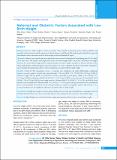Please use this identifier to cite or link to this item:
https://hdl.handle.net/20.500.14356/1344Full metadata record
| DC Field | Value | Language |
|---|---|---|
| dc.contributor.author | Yadav, Dilip Kumar | - |
| dc.contributor.author | Shukla, Girija Shankar | - |
| dc.contributor.author | Gupta, Neena | - |
| dc.contributor.author | Shrestha, Naveen | - |
| dc.contributor.author | Singh, Akanksha | - |
| dc.contributor.author | Kaphle, Hari Prasad | - |
| dc.date.accessioned | 2023-05-08T07:12:23Z | - |
| dc.date.available | 2023-05-08T07:12:23Z | - |
| dc.date.issued | 2019 | - |
| dc.identifier.citation | YadavD. K., ShuklaG. S., GuptaN., ShresthaN., SinghA., & KaphleH. P. (2020). Maternal and Obstetric Factors Associated with Low Birth Weight: Matched case control study. Journal of Nepal Health Research Council, 17(4), 443-450. https://doi.org/10.33314/jnhrc.v17i4.2263 | en_US |
| dc.identifier.issn | Print ISSN: 1727-5482; Online ISSN: 1999-6217 | - |
| dc.identifier.uri | http://103.69.126.140:8080/handle/20.500.14356/1344 | - |
| dc.description | Original Article | en_US |
| dc.description.abstract | Abstract Background: Low birth weight is a factor associated with perinatal, neonatal and post-neonatal morbidity and mortality and is associated with development of chronic diseases in adulthood. This study aimed to identify the maternal and obstetric factors associated with low birth weight in selected hospitals of Nepal. Methods: Matched case control study was conducted in two tertiary level hospital of Nepal during May 2017 to April 2018. There were 368 mothers with single full term live low birth weight babies (cases) and 736 mothers with single full term live normal birth weight babies (controls) matched on babies’ gender and place of delivery included in the study. Multivariable conditional logistic regression analysis was used to eliminate the effects of potential confounders and to identify the independent effect of various risk factors associated with low birth weight. Results: A total of 1104 respondents (1 case : 2 controls) were included in the study. Multivariable conditional logistic regression analysis revealed that maternal height <146 cm [AOR 5.14, (95%CI:2.03-13.01),(p=0.001)], maternal weight ?50 kg [AOR 3.75,(95%CI:2.15-6.56), (p<0.001)], primi-parity [AOR 4.58, (95%CI:1.71-12.25),(p=0.002)], multi-parity [AOR 3.01,(95%CI: 1.11-8.12),(p=0.030)], rest in day time ?2 hours [AOR 3.68, (95%CI: 2.01-6.75),(p<0.001)], rest in night time for <8 hours [AOR 5.76, (95%CI: 2.32-14.33), (p<0.001)], Iron and folic acid consumption for ?60 days [AOR 5.47, (95%CI: 2.73-10.95),(p<0.001)], Iron and folic acid consumption for 61-120 days [AOR 3.04, (95%CI: 1.90-4.87),(p<0.001), no calcium consumption [AOR 3.00, (95%CI: 1.78-5.04),(p<0.001)] were the significant risk factors associated with Low birth weight Conclusions: Height and weight of women, parity, duration of rest in day time and night time, consumption of Iron and folic acid and calcium were the maternal and obstetric determinants for the occurrence of low birth weight. Keywords: Birth Weight; case control; low birth weight; maternal and obstetric factors; normal birth weight. | en_US |
| dc.language.iso | en | en_US |
| dc.publisher | Nepal Health Research Council | en_US |
| dc.relation.ispartofseries | Oct-Dec, 2019;2263 | - |
| dc.subject | Birth Weight | en_US |
| dc.subject | Case control | en_US |
| dc.subject | Low birth weight | en_US |
| dc.subject | Maternal and obstetric factors | en_US |
| dc.subject | Normal birth weight | en_US |
| dc.title | Maternal and Obstetric Factors Associated with Low Birth Weight | en_US |
| dc.type | Journal Article | en_US |
| local.journal.category | Original Article | - |
| Appears in Collections: | Vol. 17 No. 4 Issue 45 Oct-Dec 2019 | |
Files in This Item:
| File | Description | Size | Format | |
|---|---|---|---|---|
| 2263-Manuscript-13226-1-10-20200121.pdf | Fulltext Download | 700.06 kB | Adobe PDF |  View/Open |
Items in DSpace are protected by copyright, with all rights reserved, unless otherwise indicated.
